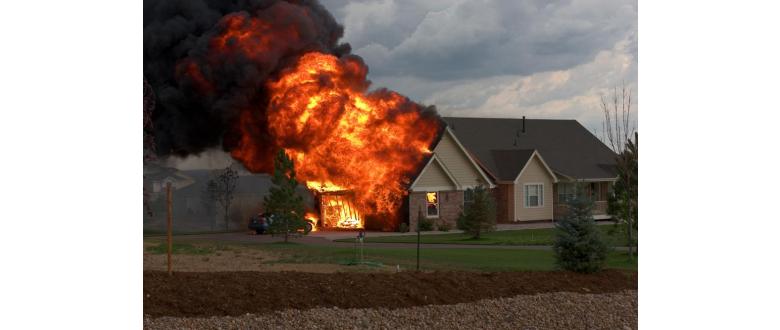October 18, 2019
0 comments
Home Security Systems with Fire Protection Sensors
Wireless sensors and remote monitoring account for the life-and-death
ties between ease of use, accessibility, and safety
If you’ve ignored the chirp of your smoke alarm—often the sign of a low battery—you’re not alone. A 2012 survey conducted by a leading fire safety manufacturer found that a third of homeowners wait a day or more to replace batteries after the beeping begins. Worse yet, an additional 7% report that they’d be likely to respond by disconnecting the battery entirely.
Strange as it may sound, chirps, false alarms, and seemingly minor shortcomings of traditional smoke alarms are—according to some safety officials—their fatal flaw. But with smart smoke and heat sensors, combined home security and fire monitoring can help eliminate some sources of failure fueling home fire deaths. In this article, we look at how home security systems with strong fire protection features provide greater safety than traditional smoke alarms alone.
Inconvenience, absence, and poor placement contribute to home
fire deaths
Nearly 60% of recent home fire deaths happened in homes with no working smoke alarms or no smoke alarms, period. Research from the National Fire Protection Association (NFPA) shows that the death rate from home fires doubles in the absence of working smoke alarms. Missing, disconnected, or dead batteries were present in almost 70% of cases where these life-saving devices failed to operate.
Vision 20/20—a project created by fire code experts, firefighters, and members of leading life-safety organizations—calls it the “smoke alarm problem.” Their research suggests a few reasons why some problems with smoke alarms linger:
- Residents may disable smoke detectors due to “nuisance alarms”—often when sensors are poorly placed or of the wrong type
- Some homes don’t have enough smoke alarms—or they’re not properly placed
- A smaller share of residents report having no smoke alarms at all
Richard Taylor, communications and research manager for the Maine State Housing Authority, writes in a report for Vision 20/20 that “proximity and utility” may sometimes be to blame. Smoke alarms usually aren’t easy to reach and, with rare exceptions, most people don’t need to interact with them on a regular basis.
“Because they are high on a wall or on the ceiling, they are not proximate. Unless we happen to be cleaning or testing the device,” Taylor says, “we don’t have a routine need to look at or touch a smoke alarm… In contrast, we are constantly using other appliances, such as the toaster, microwave, or TV.”
Home security systems with fire protection features make
smoke and heat sensors more convenient, usable, and safe
Research suggests that false or “nuisance” alarms lead some to ignore or disconnect battery-powered smoke alarms. If that’s the case, being able to easily stop nuisance alarms—or, better yet, to prevent them entirely—could make many homes noticeably safer. And, in that sense, pairing fire protection equipment with the features of modern home security systems can deliver big benefits.
Because smoke and heat rise, detectors should be placed high on most walls and ceilings. That’s true for both traditional smoke alarms and for smart smoke and heat sensors. But this height doesn’t mean that hard-to-stop nuisance alarms are inevitable. Like other environmental sensors, alarms from detectors connected to home security systems can be stopped through a user’s smartphone. That means that homeowners can place smoke detectors wherever they’re most effective (even if the location is well out of reach) and still silence them with little effort.
There’s also another area where the design of smart smoke and heat detectors encourages good decisions: getting batteries replaced. Many old-school smoke alarms need new batteries installed once or twice a year. Smart smoke and heat sensors can last longer, with batteries that endure for roughly ten years. And when it’s time to replace the battery—or the system detects a different malfunction—the home security system sends push notifications to users (rather than that annoying beeping in the middle of the night).
Pairing home security and fire monitoring can lead to
earlier detection and fire protection—while home or away
Robust sensors, monitoring professionals, and first
responders team up to save lives
Home security and fire monitoring should, ideally, go hand-in-hand. Integrated smoke and heat sensors can send a signal to the same professionals tasked with contacting emergency services during a home intrusion. Early notification—and action—can save both homes with fires in them and the residences surrounding them.
In a nutshell, combined home security and fire alarm monitoring work like this:
- First, the smart smoke and heat detector activates and sends a signal to the hub.
- The hub sounds an audible alarm and relays that signal through a cellular connection to the monitoring center, which has licensed personnel standing by.
- An operator attempts to contact the user (homeowner or renter) to confirm that there’s a fire.
- If there’s no answer, no confirmed system user, or a confirmed user and fire, the operator contacts local authorities.
Unlike home intrusion sensors which are routinely armed and disarmed, smoke and heat sensors are always on to achieve around-the-clock safety.
For users who are home when a fire breaks out—including individuals who may be incapacitated—this process guarantees that help is on the way. And depending on the design of a particular detector, fires may be detected sooner—and help dispatched earlier—in houses protected with a home security and fire monitoring system. As the National Fire Protection Association and other authorities note, sensors that combine multiple technologies offer the best protection. For example, Frontpoint’s smoke and heat detectors use:
- Ionization sensors—good for picking up fast-moving fires
- Photoelectric sensors—able to sense slower-burning fires
- Fixed temperature sensors—activated at a preset temperature
- Rate-of-rise sensors—triggered when surrounding temperatures rapidly increase
In smart home security systems, these can be paired with carbon monoxide (CO) sensors for an additional layer of safety. While they’re not used for detecting fast-moving fires, carbon monoxide sensors can pick up on smoldering fires (or any other sources of CO) and, like smoke and heat sensors, send signals to monitoring personnel. The difference, however, is that Frontpoint personnel do not attempt to contact the owner before dispatching emergency services when a CO sensor triggers. Because the gas is so deadly, so quickly—and may incapacitate anyone inside the home—help is immediately summoned.
Monitoring provides essential services for those who leave
home for long periods of time
A story from Empire, Alabama illustrates why monitored fire and home security systems are important. When the Winchesters, a family of five, returned from vacation just five hours south, the last thing they expected was to find that their house had been set alight not once, but twice, and most of it was destroyed.
“The fire department had come and put the front of the house out,” said Michelle Winchester, “and about 15, 20 minutes later they got called back. Whoever had set it on fire had come back and set the back of the house on fire.” Worse yet, the family had been robbed—and by the time they returned, they could salvage little but the family photos.
Homeowners and renters protected by home security and fire monitoring systems can have vastly better outcomes. Years ago, we reported on a Salem, Ohio couple whose home started to burn when a clogged heating device caught fire. They weren’t home but had monitored fire protection—and in less than an hour, firefighters had stopped the fire and saved their home.
Stories like these show how modern technology can help homeowners and renters take security and fire safety into their own hands. Traditional smoke alarms have only one job: to make a noise loud enough—and, for the hearing-impaired, to flash lights brightly enough—to get people out of their homes quickly. But the electronics used with monitored systems provide a link between a burning home and those tasked with protecting it.
Users can check in on their homes using cameras to get a look at the situation inside. Or, they can rely on email and text notifications that specify when a sensor in the home is triggered. And, as always, monitoring professionals are standing by to take action when detectors activate.
The technology that makes home security affordable and
powerful has a promising future in fire protection
Smart alarms are—in more than just a marketing sense—the future of fire detection. Treye Thomas, a staff member with the Consumer Product Safety Commission, imagines a new era of safety on the horizon. Revised safety will reduce the number of nuisance alarms, he suggests, by relying on multiple sensor types. And detectors may be much smaller (“no larger than a quarter”), built into electronic devices throughout the house, and able to communicate with smart security systems.
While there’s no telling what’s next, today’s best home security systems already feature a blend of time-tested fire safety electronics with emerging technologies for a safer, and more convenient, experience. With robust notifications, integration with a variety of sensors, and professional monitoring, today’s consumers have the power to keep their families and homes better protected than ever before.
Frontpoint keeps families safer and more connected in their everyday lives. We've been revolutionizing the home security industry for over a decade. And we're just getting started. To shop home security systems with fire protection, check out our Smoke and Heat Sensor and Carbon Monoxide Sensor—or browse our Security Packages. If you have questions or would like to discuss a quote, contact us at 1-877-602-5276.







 Contact us
Contact us